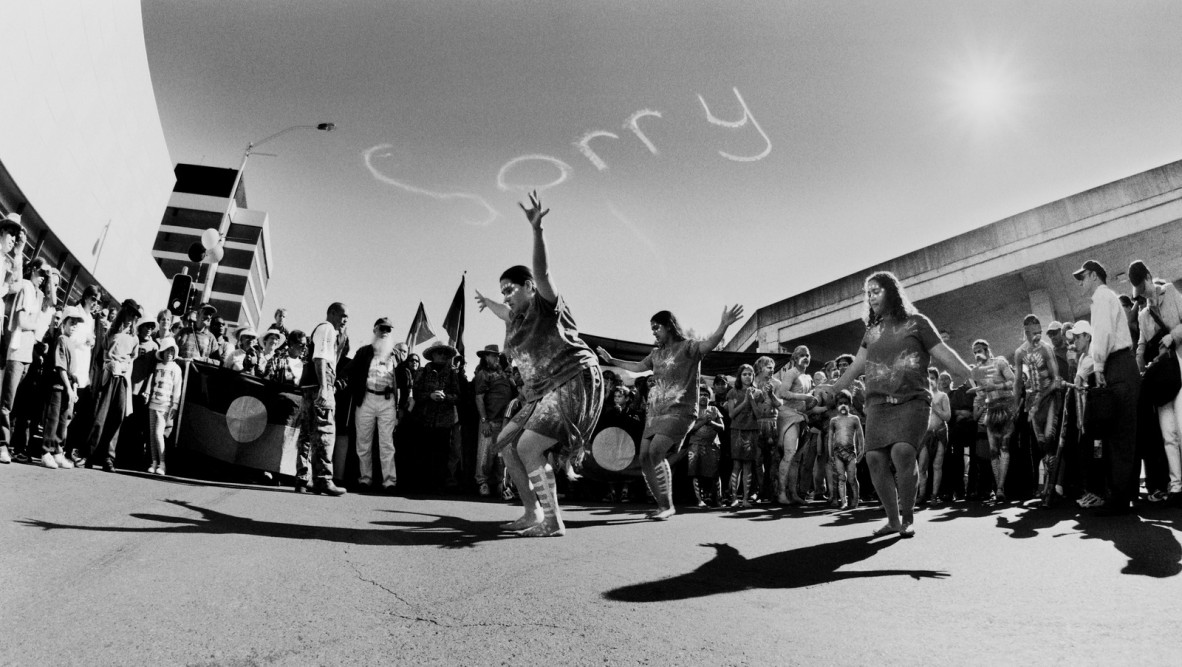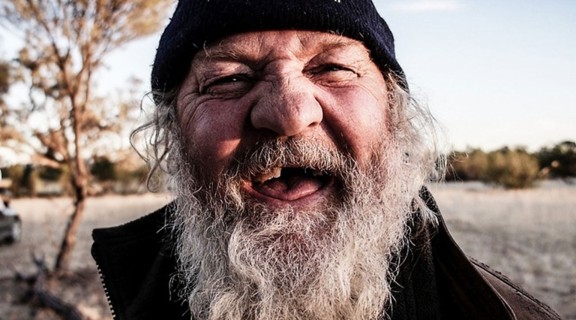Politics and people power: rule makers and rebels
By Tamara Crew | 30 September 2020

State Library of Queensland has grown a vast photographic archive reflecting the lives of generations of Queenslanders. Our first every fully online exhibition TWENTY, recalls the last 20 years through our contemporary collections.
We asked independent artist, curator and writer Shannon Brett to reflect on the politics and people power theme of TWENTY.
Politics & people power: Rule makers and rebels
By Shannon Brett
TWENTY, as a photographic exhibition showcasing imagery from the State Library of Queensland’s archives, demonstrates precisely how complex and diverse our state is through a compilation of rich and powerful themes; those which have transpired between the years 2000 - 2020. Photography remains a powerful tool of communication, and these selected works embrace the stories of Queenslanders while following the shifting tides of our lives across various communities. Whether uplifting or causing us pain, these are our realities. The exhibition also highlights a range of dedicated documentary photographers who have had lengthy careers, providing us as viewers with a graphic acumen of our sunshine state like no other.
As Queenslanders navigating our way through our twenty-first-century life cycles, we hold more power than we have ever had available to create the change that we need for a world that we want to live in. The theme Politics & people power: Rule makers and rebels highlights our state’s devotion to political activism and to demonstrations responding to the current frameworks in which our communities operate. This theme also urges viewers to focus on our political leaders as well as our political failures.
An organised congregation of individuals united in demonstration for a cause that they passionately believe in is, in its essence, a pure and undeniable act of love. It is an act of commitment, of care, and of a desire to communicate at a political level; an act that empowers demonstrators to represent a silenced voice or to create change for the better futures of our state and of our national communities.
This worthy action—called protest—is documented and recognised within the Australian Constitution and it’s a space through which we can challenge a failing system, and where we can freely voice our opinions and our lived experiences. Protest is a community, a construction, a wit’s end battle, a performance, a passion, and a devotion.
In Australia, we protest for our civil, social, and human rights; this is our choice. However, as Wiradjuri journalist and author Stan Grant observes in relation to media coverage of Aboriginal protests around the celebration of Australia (Invasion) Day, there are sometimes skewed perceptions of who should be allowed to protest what:
The starting point from a lot of the coverage is that this is somehow illegitimate. It’s ‘us’ and ‘them’. ‘You’re raining on the parade’. ‘Why can’t you all celebrate?’ I think there is no greater celebration of what a nation is supposed to be about than the ability to take to the streets and say ‘This is where our nation fails us’. So I think the media starts off and starts out with a question that the Aboriginal voice and the Aboriginal protest is somehow illegitimate—when in fact it should be something that we should cherish.i
In recent times, there has been a resurgence in our nation’s outcry against the deaths of Indigenous people, notably stimulated by the Black Lives Matter movement that is addressing the horrific and tragic events surrounding black deaths in the United States. Comparatively, Aboriginal and Torres Strait Islander peoples who have experienced racial violence or who have been brutally murdered via our failed judicial system, continue to remain invisible, generally having had no justice served for the crimes committed against them. At the time of writing, 437 Indigenous deaths in all forms of custody have been recorded in Australia since 1991, yet no-one has ever been convicted of these murders.
Early activism in Australia began with Aboriginal people pressing for equality by seeking freedom from being hunted to death on their own lands and pursuing the right to obtain equal citizenship to and by the new Australians. The 1938 Day of Mourning protest was the largest of its kind, coinciding with the 150th anniversary of British colonisation in Australia. A statement by Traditional Owners was delivered:
WE, representing THE ABORIGINES OF AUSTRALIA, assembled in conference at the Australian Hall, Sydney, on the 26th day of January, 1938, this being the 150th Anniversary of the Whiteman's seizure of our country, HEREBY MAKE PROTEST against the callous treatment of our people by the whitemen during the past 150 years, AND WE APPEAL to the Australian nation of today to make new laws for the education and care of Aborigines, we ask for a new policy which will raise our people TO FULL CITIZEN STATUS and EQUALITY WITHIN THE COMMUNITY.ii
This statement and many more that supported the Day of Mourning eventually resulted in a referendum (1967) that provided Aboriginal people citizenship status in their own country. Within a decade after the referendum, the National Aborigines and Islanders Day Observance Committee (NAIDOC) was underway. Now, we celebrate NAIDOC Week in Queensland each year in early July. Public marches for NAIDOC Week place ‘people power’ on show via peaceful protests and demonstrations. These are some of the rallies that significantly represent the power of Aboriginal and Torres Strait Islander cultures and how they endeavour to exist for the love and expectations of a monumental cultural philosophy and spiritual way of life. NAIDOC Week is a time for Aboriginal and Torres Strait Islander peoples to come together, to share stories with a national audience, and to celebrate the cultures that are the foundations of this nation.
Images produced by Queensland documentary photographer Jo-Anne Driessens record human responses that follow the journeys and creations of stories. Her powerful photograph featured here in Politics & people power: Rule makers and rebels documents an influential moment that has contributed to making our state and our country what it is. Her photographs help us to accurately recall or reminisce upon Queensland’s desire to create a civic political change, for a fairer society, or to observe bold yet daring rule makers and breakers in action.
Driessens is a Koa woman with historical connections to the Cherbourg (Barambah), Woorabinda and Yarrabah communities, who discovered her passion for photography in high school through a series of evening photography classes she attended. Her photograph Dancers performing during the Walk for Reconciliation in Brisbane, Queensland, 2000 is a powerful image that was taken from the very front of the 70,000-person strong rally which supported a coming together of our national community: a call for reconciliation.
Driessens holds an incredible and authentically powerful ability to communicate with her camera. She places Indigenous stories at the forefront of each image, creating an instant moment in time that becomes a valuable, eternal resource and archive.
This image has been repeatedly utilised in numerous ways by many people since its initial publication twenty years ago. However, for the photographer, it will remain a memory of pride for her people and also as an image that liberates Aboriginal women, here as subject and photographer.
Politics & people power: Rule makers and rebels captures the social dynamics of protest and the power of our people, as conspicuously visible. TWENTY urges viewers to follow these stories, to know these documentary photographers, and to understand how these images came into existence.
This theme reminds us that if we can’t see a problem, we can’t fix a problem—and there is no harmony in silence.
About the author
Shannon Brett is a descendant of the Wakka Wakka, Butchulla and Gurang Gurang peoples of southern Queensland. Brett is an interdisciplinary artist who creates and designs artworks indicative of their experiences as an Aboriginal person living and surviving in modern, urban Australian society. Brett also works extensively as an independent art curator, writer, trainer and arts manager, motivated by art that operates at the juncture of cultural politics and visual practice. Additionally, Brett maintains their position on the Editorial Board for Garland Magazine and is a current Board Member of Brisbane’s artist-run organisation, Boxcopy. Brett focuses on issues that are close to heart, which are the survival, integrity, and sovereignty of Indigenous peoples.
References
i Stan Grant, The Point panel, aired on NITV, posted on Instagram 23 January 2019, https://www.instagram.com/p/Bs9I2aOl2Ya/?igshid=6w91m8r1ev81.
ii AIATSIS, “We Hereby Make Protest: The 1938 Day of Mourning”, https://aiatsis.gov.au/exhibitions/daymourning-26th-january-1938.

TWENTY: two decades of Queensland photography
Remember, see and feel the last 20 years in an online exhibition of State Library of Queensland’s contemporary photography collections.
Comments
Your email address will not be published.
We welcome relevant, respectful comments.